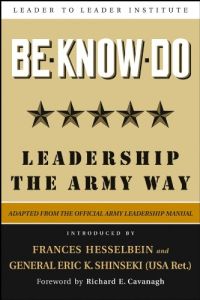Join getAbstract to access the summary!

Join getAbstract to access the summary!
Leader to Leader Institute, Frances Hesselbein and Gen. Eric K. Shinseki
Be Know Do
Leadership the Army Way: Adapted from The Official Army Leadership Manual
Jossey-Bass, 2004
What's inside?
Anyone with honesty, competence and the ability to deliver can lead. Add communication skills and you may be the next Patton.
Recommendation
Leadership often is assigned a mystical quality, as if people either possess the spark that makes others follow them, or they don’t. Well, now you can lead without the innate spark. In fact, the U.S. Army sets out to prove that anyone can become a leader, as this engaging book from the Leader to Leader Institute explains. Using The Army Leadership Manual (abstract available from getAbstract) as its foundation, this volume demystifies leadership. Promisingly enough, this speedy read persuasively argues that being a leader requires little more than honesty and competence. Throw in an ability to communicate and a willingness to listen to your people, and you could become the next Patton, or at least a respected officer. This enlightening tome is a little thin on ways to turn its leadership development philosophy into action. Still, getAbstract.com recommends it to managers and to those who strive to become leaders.
Summary
About the Authors
The New York-based Leader to Leader Institute, formerly the Drucker Foundation, is a nonprofit group that publishes books and videotapes, and offers leadership workshops. Frances Hesselbein, its chairman, is the former CEO of the Girl Scouts of the USA. Gen. Eric K. Shinseki retired from the Army in 2003 after a long career, including service as Army Chief of Staff.




















Comment on this summary